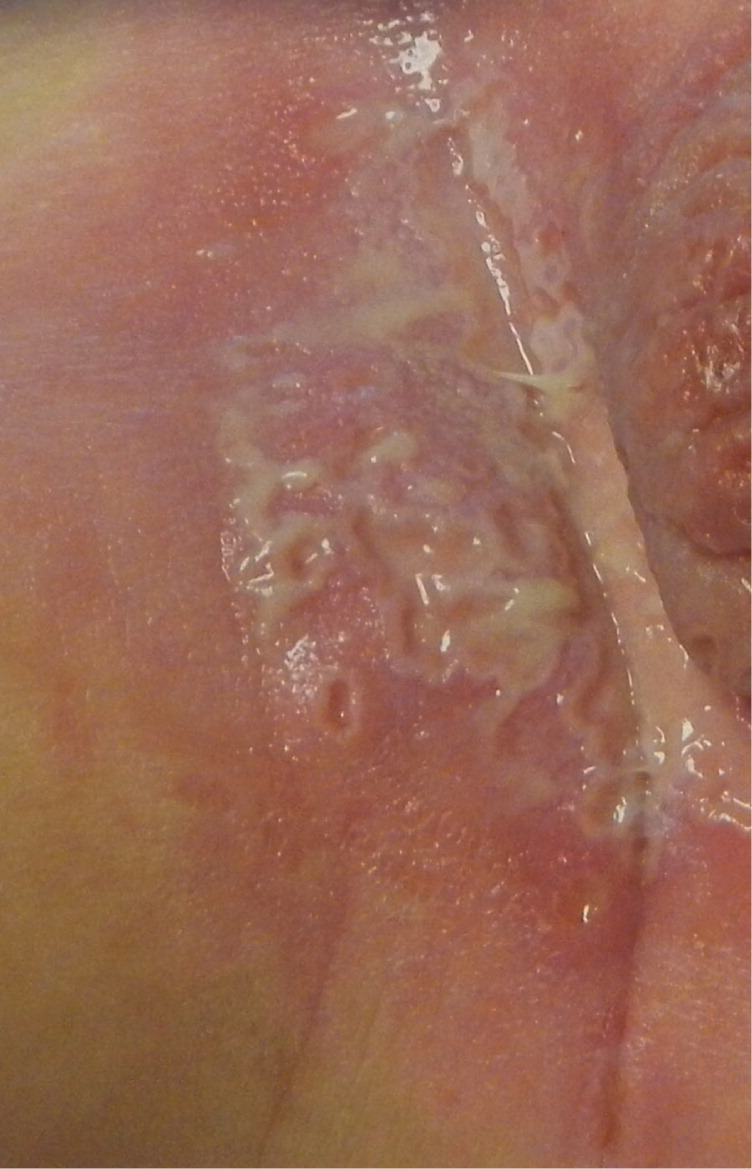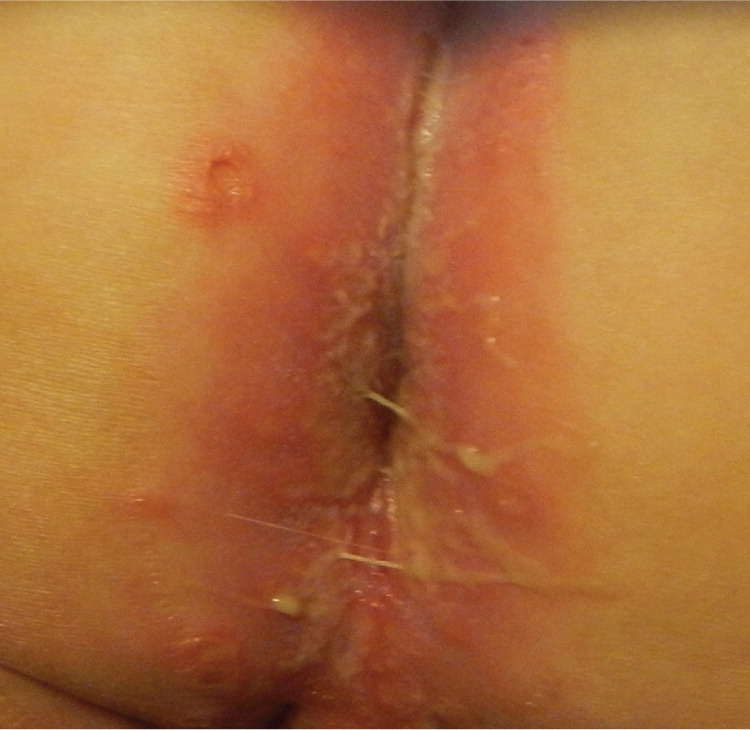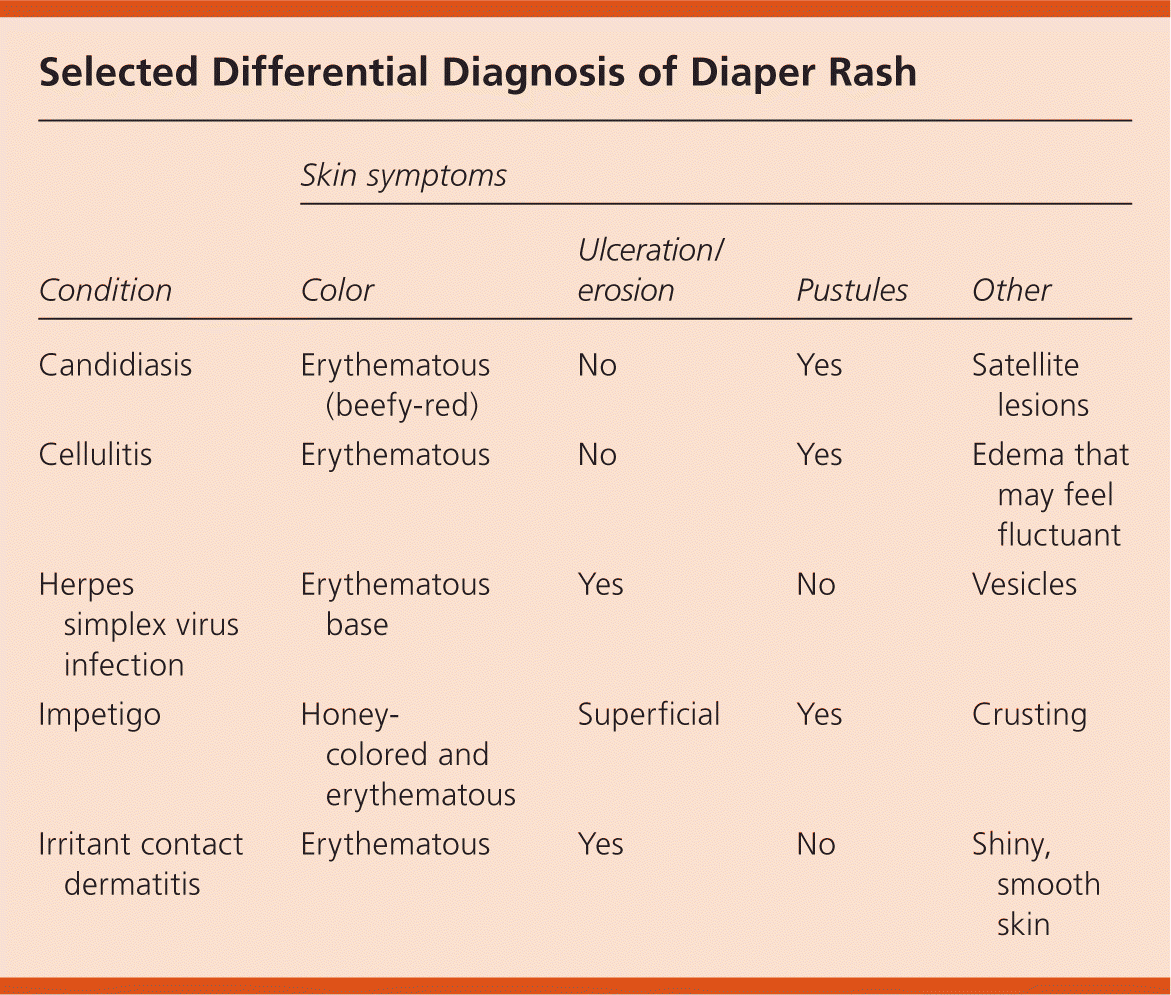
Am Fam Physician. 2014;89(12):973-974
Author disclosure: No relevant financial affiliations.
A 14-month-old boy is brought to his physician's office because of a diaper rash. Three weeks earlier, he was seen in the emergency department for a beefy-red, plaquelike perineal rash with multiple erythematous papules. The rash did not improve with over-the-counter topical creams and topical nystatin alone, but responded briefly to a regimen of oral cephalexin (Keflex) and fluconazole (Diflucan) with topical nystatin cream. The patient subsequently developed white bumps and blisters in the diaper area and a fever of 105°F (40.5°C). His mother reported that she had recently developed lesions on her lip that crusted over and resolved within a few days.
Physical examination revealed multiple vesicles with discharge in the groin and perineum. There was significant erythema in the groin, perineum, and scrotal area with multiple ruptured and intact vesicles that were 0.3 × 0.3 cm in size (Figures 1 and 2). Ulcerated skin was observed in the gluteal cleft and intertriginous areas. The infant was admitted to the hospital for treatment.


Laboratory testing showed an elevated C-reactive protein level of 2.08 mg per L (19.81 nmol per L) and a white blood cell count of 23,000 mm3 (23 × 109 per L). Vesicle fluid was collected for bacterial and viral testing.
Question
Discussion
The correct answer is A: acyclovir. This infant presented with lesions characteristic of herpes simplex virus (HSV) infection. This can be diagnosed clinically by the presence of papules and vesicles on an erythematous base that can become umbilicated, rupture, and ulcerate.1,2 His mother's oral lesions from herpes labialis (cold sores) during the period she was treating his diaper rash make transmission of HSV-1 to the abraded perineum the most likely etiology. This was confirmed by polymerase chain reaction testing of the vesicle fluid. Direct fluorescent antibody testing or viral serology can also be used to test for HSV.2 Treatment with acyclovir or valacyclovir (Valtrex) can shorten duration and alleviate symptoms of outbreaks.1
HSV invades through skin or mucous membranes. It replicates in epithelium before traveling via sensory nerve roots to dorsal root ganglia, where it establishes latency. Reactivation can initiate a mucocutaneous outbreak; however, subclinical viral shedding can also occur.1,2 Transmission is most commonly through contact with the secretions or mucosal surfaces of an infected individual, regardless of the presence of lesions. It is estimated that 70% of transmissions result from asymptomatic viral shedding by a person unaware of the infection.3 Infants can be exposed to viral shedding from an infected caregiver during diaper changes and baths. Sexual transmission is less likely in children younger than five years. In all cases of genital herpes in children, sexual abuse should be considered.4
HSV-1 infection normally occurs in childhood and adolescence, often in the oral mucosa. HSV-2 infection usually occurs in the teenage years, causing genital herpes, but the prevalence increases as the population ages.5 Both HSV subtypes can produce lesions in the mouth and the genitals. New HSV-1 infections are as likely to involve the genitals as the orolabial area.4,6 Worldwide, the prevalence of HSV subtypes varies widely depending on population, sexual practices, and geography.5
Fluconazole is used to treat candidiasis, which can present with diffuse erythema in addition to beefy-red plaques, pustules, and satellite lesions.7 There may be white debris in the skin folds.
Mupirocin would be appropriate for minor superficial skin infections, such as impetigo. Impetigo may present with localized erythema and crusting, honey-colored lesions.
Vancomycin would be appropriate to treat methicillin-resistant Staphylococcus aureus skin infections, which may manifest as papules and pustules on erythematous, tender skin. These smaller lesions can progress into abscesses with central necrosis that require incision and drainage.8
Zinc oxide cream is used to treat irritant dermatitis, which presents with erythematous, smooth, and shiny perineal skin. Erosions and ulcerations can occur in advanced cases, such as with infrequent diaper changing.7

| Condition | Skin symptoms | |||
|---|---|---|---|---|
| Color | Ulceration/erosion | Pustules | Other | |
| Candidiasis | Erythematous (beefy-red) | No | Yes | Satellite lesions |
| Cellulitis | Erythematous | No | Yes | Edema that may feel fluctuant |
| Herpes simplex virus infection | Erythematous base | Yes | No | Vesicles |
| Impetigo | Honey-colored and erythematous | Superficial | Yes | Crusting |
| Irritant contact dermatitis | Erythematous | Yes | No | Shiny, smooth skin |
